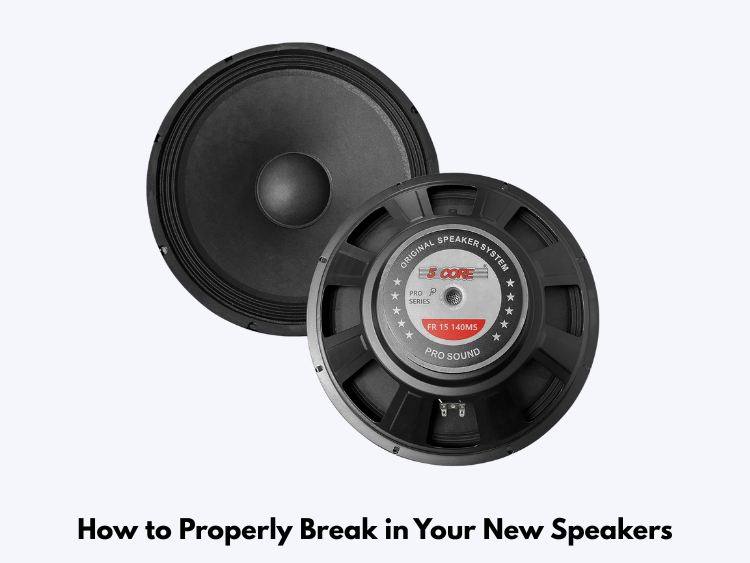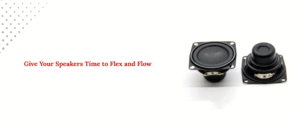You should be proud that you got new speakers. New speakers can make a huge difference in how you enjoy music and movies, whether they’re in your car, home theater, or high-end sound system. Putting on your favorite music is great, but there’s an important step you shouldn’t skip before you do that: breaking them in. If you take the time to break in your speakers the right way, they will work better and sound better. This article will talk about why it’s important to break them in, how to do it right, and what to expect while the process is going on.
What’s the Point of Giving Speakers a Break?
Speakers are industrial devices that are made from metal, rubber, paper, and cloth. When they are first manufactured, these parts are stiff. This is especially true for the speaker’s support system, which is made up of the spider (a ribbed disc that holds the voice coil in place) and the surround (the bendable ring that goes around the cone).
When you break in your speakers, these parts have time to relax on their own. As the speaker bends and moves, it will start to make sounds that are clearer and more accurate, especially in the bass range. Your speakers might sound tight, stifled, or a little harsh at first if you don’t give them time to break in.
To better understand what kind of speaker you might be breaking in, it’s helpful to know the difference between woofers and subwoofers.
How Long Does It Take?
The exact break-in time depends on the type of speaker, its brand, and its materials. Some makers say that the battery can last anywhere from 20 to 100 hours. Most of the time, after 40 to 50 hours of modest use, the sound quality will get a lot better.
It’s important to remember that the break-in process doesn’t have to be done all the time. Your speakers will simply break in over time with normal daily use. You can speed up the process, though, by using certain methods.
How to Break Your Speakers the Right Way
1. Pick Speakers the Right Music
You want songs with a lot of different sounds for a good break-in. Albums and tracks with strong bass, clear mids, and clear highs are good choices. It’s best to listen to complicated music like jazz, symphonies, or rock. If you only use bass-heavy tracks, your speakers won’t get the exercise they need across the whole frequency range.
2. Begin with a Moderate Volume
The first few hours should have music that is about as loud as a regular talk or a little louder. Starting out, don’t turn up the volume too high because the still-stiff parts can’t bend easily yet, and you could damage the speakers.
You want to slowly add movement and flexibility without pushing too hard, like when you stretch before a workout.
3. Slowly Add More Volume in Speakers
You can turn up the volume a little after the first 10 to 20 hours of soft listening. Although you can enjoy some louder sessions, it’s best to stay within the speaker’s suggested working range. It’s important to do this step because it frees up the suspension parts so they can work at their best.
For help selecting long-lasting speakers that break in well, browse the top 5 car replacement speakers for superior sound quality.
4. Play Pink Noise or Different Kinds of Music
You can speed up the process by using pink noise (a sound like static electricity that fills all frequencies evenly) or certain “break-in tracks” that you can find online. For a few hours at a time, play these songs at a low speed. Take breaks between sets to keep your tools from getting too hot.
A lot of audio fans swear by pink noise because it stresses all the parts of the speaker cone and suspension system in the same way.
5. Wait Your Turn and Pay Attention
Not only is breaking in speakers a technical process, but it’s also a chance to listen to how the sound of your system changes over time. You’ll start to notice changes as you listen for longer: the bass will get deeper, the highs will get softer, and the general sharpness and dynamic range will grow.
Remember that small changes happen over time, so be patient.
Last Thoughts
It might not seem necessary to break in your new speakers, but it can make a big difference in how they sound overall. It makes the difference between a good speaker and a great one.
The break-in process is like giving your speakers a chance to “stretch their legs” and work at their best. By being patient, picking a variety of music, starting at a modest volume, and slowly turning up the volume, you’ll end up with sound that is deeper, more detailed, and richer that you can enjoy for years to come.
If you’re still exploring speaker options for home audio, check out the best replacement speakers for home audio in 2025.




